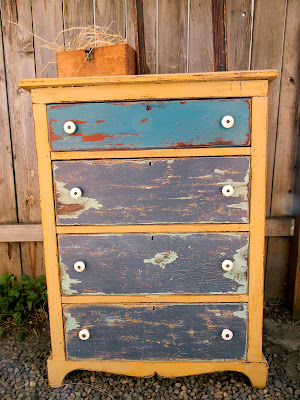Im going to attempt to share my techniques with you, well to state at the beginning I have a degree in fine art and really like to paint. But Im NOT a meticulous person, Im very spontaneous and like things done quickly. I embrace what I like to call "happy accidents" Im never afraid to try new things or colors because I know that if I don't like it I can just paint over it or sand it off. Well with that all said I can begin, and if I leave out details or info that you want to know just send me an email and I will do my best to answer.
1. Weathered look using crackled glaze
On this dresser I wanted it to look as rustic as I could, like it was just pulled out of a barn. The original color was a deep red. I use Behr paint from Home Depot because it has the paint with primer in it. Translation I don't have to sand as much if at all. I only sand if I do repairs with wood patch or if there are dark oily spots or water stains. Sometimes if I want a really distressed look and the piece already has paint chipping off I won't sand it until I paint it, that way when I do sand it I get that really chippy look.
For the drawers on this dresser I wanted the layers off paint to show through, I like to use a crackle glaze (I get mine from Lowe's) I usually paint a light and bright color first because it will show through the cracks best without being too overwhelming. Then I wait and hour and paint on my darker color. On this dresser I used a light color over a brown but after it dried I was not happy with it so I did another layer of grackle glaze and then the blue. The first drawer I did crackle glaze right on top of the original red and then the teal. Before this dried all the way I took a hard piece of plastic (maybe even my nails, shhh) and scraped/chipped off some of the paint.
Finally I sanded all the edges and sealed it with a water based polyurethane.
These are some more examples of the use of the crackle glaze to create the weathered look.
Above: I used two different hues in the same yellow family and a little light sanding on the edges.
This one I used a bright green underneath the softer blue/green color and did not sand or scrape.
on the dresser below I used a deep yellow underneath and soft yellow on top and used making tape and a ruler to do the blue/green stripes.
Sometimes a piece of furniture will be in good condition except for the top and if I end up doing a lot of repairs and wood patch I try to disguise it with layers of crackle glaze and paint (and no one is the wiser)
Below example of rustic farmhouse look with tow layers of light and dark green finished off with a antiquing glaze.
2. White washed look
Well that's what I call it anyway, I basically take a piece of furniture and paint it how I want it bright colors lots of contrast trying to accentuate all the details. When its dry I take my off white paint and mix it with water then paint the entire piece giving it a soft aged look.
On this one I used a layer of crackle glaze and then the white wash.
On this table and dresser I used a taupe color and the white washed the white over it. I sanded the edges and then used an antiquing glaze to finish the look.
3. Vaseline
Well basically I took real vaseline and rubbed it on the edges and spots around handles really anywhere I didn't want the paint to sick. Then painted the furniture as normal when it was almost dry I took a hard piece of plastic (an old credit card) and scraped off the paint where the vaseline was. You can see where the vaseline was it bubbles a little. The look you get is more of a natural aged look where the paint flakes and chips over time.
4. Dry Brushing
Top Secret
This is my little secret weaponed, I use this Rub n' Buff on everything! If I have hardware from an old dresser that is the dreaded brass color or if it not aged enough. I just rub this stuff on and poof I don't have to buy new hardware.
I thought for once I would use it for its intended purpose, that is for aging picture frames. Well at least I found it in the picture framing section of the craft store. They have several colors to choose from but the one I like is the Spanish copper.
I got this nice picture but I thought the gold frame just looked tacky in my house. I just rubbed on my Rub n' Buff I used a paint brush for the places my fingers couldn't reach.
It dries quickly and has the consistency of shoe polish, I sometimes need paint thinner to clean out my brush but it usually comes off my finger with a little soap and scrubbing.
All said its a cheap alternative to replacing hardware or picture frame.




































